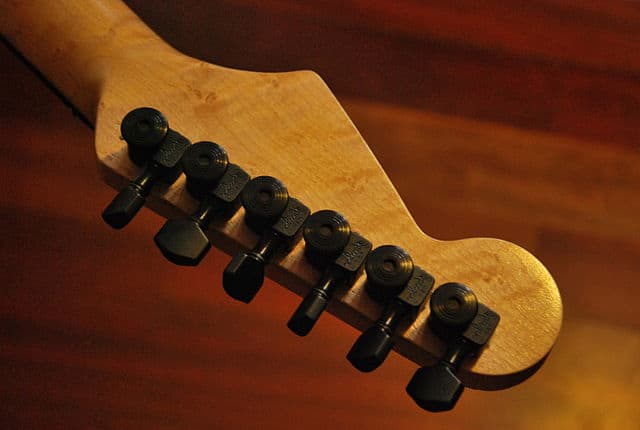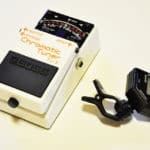Having a guitar is wonderful.
Unfortunately, it requires too much maintenance.
One must be constantly changing its strings, protecting it from harsh weather, avoiding it from receiving big blows, and the list goes on.
Some issues are easy to solve, while others require the help of professionals.
Now, there is yet another problem regarding guitars, although this time not related to any physical damage.
We are talking about detuning. It is not a disgrace, but having your guitar go out of tune often is a nuisance.
Therefore, someone invented a solution for it: locking tuners.
Locking tuners work great at keeping strings in tune, even if you play with a whammy bar.
All things being said, it is true that not every guitar has one of these.
So, the question is, if locking tuners are so effective, why not all guitars have them?
Not all guitars have locking tuners because they are not necessary. Despite their effectiveness, they are not pivotal for their functioning. Plus, installing locking tuners adds to the cost, so it is not convenient for mass production.
Not only will we answer this doubt more thoroughly, but we’ll also provide alternatives to it.
What’s more, we’ll discuss certain tips you can implement to avoid the guitar going out of tune.
Find all of these and more below!
Are locking tuners really effective?
There is no denying that locking tuners are effective.
Their function is to lock guitar strings in place, which all in all, creates certain advantages.
First of all, fewer string windings are required to keep the string in tune. This makes it simpler to put strings on the guitar.
Second, guitars that have a tremolo system are less likely to go out of tune if they have locking tuners.
Using the tremolo bar (also known as the whammy bar) consecutively puts the instrument out of tune.
This occurs because, when using the whammy bar, you are losing and raising the tension on the string. Eventually, the strings dismantle from the tuning post.
On the contrary, a locking tuner gets rid of this problem by locking the strings to the tuner and avoiding them from slipping.
So, to sum up, the main advantage of the locking tuners is that they provide tuning stability.
Why don’t all guitars have locking tuners?
Now, if locking tuners are so useful, why don’t all guitars have them?
Well, let’s begin by mentioning one disadvantage that locking tuners have: weight.
Locking tuners give extra weight to the instrument in the part of the headstock, making it a bit more uncomfortable to play and maintain when standing up.
Needless to say, this detail passes unnoticed when compared with the useful benefits that the locking tuner provides.
So, there must be more reasons other than weight, right?
Consider that, despite its resourcefulness, locking tuners are not necessary. This means that adding them to the guitar would mean a significant increase in the cost of production.
Compare them to pickups or volume pegs. They are a must for guitars to work properly.
But locking tuners? Not really.
So, an extra add-on would mean an extra payment.
Lastly, consider that locking tuners are relatively new. That is to say, they‘ve been around for not too long.
They hit the market in the early ‘80s. By that time, there were already Rock N’ Roll colossi that didn’t play with locking tuners, including Led Zeppelin and Black Sabbath.
This seems like a minor detail, but in fact, makes lots of sense.
Since these bands defined a music style, many groups wanted to “copy” their playing style and looks. That includes using similar gear.
Even today, “vintage” music and style are still appreciated by new musicians, making them prefer to lean toward “classic” designs.
Plus, let’s not forget: Unless playing with the whammy bar is part of your style, a locking tuner is not a requisite.
What are some alternatives to locking tuners?
There’s no need to waste on locking tuners. Instead, use one of these alternatives.
First, use locking nuts. They are a type of guitar nut that brackets the string and avoids detuning.
Also, start tuning from low to high. This ensures the tuning stability lasts longer.
You must tune from low to high instead of high to low, even if you want a lower tuning (for instance, for a drop D tuning, go down to C or C#, then tune up until you reach D).
Lastly, I encourage you to try this technique:
When stringing your guitar, turn your tuning pegs until the hole in the post is pointing downwards (that is, the post’s hole should be pointing towards the fretboard). Then, pass the string through the hole and properly place it in the nut.
After that, bend the string towards the center of the headstock.
If you don’t understand how to do it, picture a Gibson Les Paul in your head. It will serve to exemplify this method.
So, when placing the sixth, fifth, and fourth strings in the hole pots (of the Les Paul), you should be bending the strings to the right. When putting the third, second, and first strings, you must bend them to the left side.
Remember, always towards the center of the headstock. Needless to say, the direction will vary depending on the tuning peg positions.
So, after bending, pass the string’s point under the string and bend it back (over the string). That way, the string indents in the tuning post.
When you start to gradually tighten the string, it will lock itself, and reinforce tuning stability.
We highly recommend watching a tutorial on Youtube to fully understand this technique.
Locking tuners are great, but maybe one of these alternatives suits you better.
How to improve the tuning stability of a guitar?
Improving stability is not a tough task.
You may, for instance, tune from low to high, as we mentioned in the section above. That way, the string will go out of tune less regularly.
Also, try lubricating the nut. Strings hung up in specific contact points, such as the nut, but lubrication solves the issue.
There are different forms of doing it.
You could lubricate it with (you guessed it) lubricants! However, there are some homemade alternatives to try, like rubbing a pencil against the nut.
After all, graphite is a good lubricant, although chapstick will work as well.
But why deal with problems when you could find solutions beforehand?
Begin by installing the strings properly. That means firmly seating the string at the ball end of the string.
Furthermore, use as few neat winds as possible when wrapping the strings.
Last but not least, change your strings regularly. Old, rusted strings not only are more prone to break, but they also go out of tune sooner.
Final thoughts
All in all, you don’t have to get a guitar with locking tuners.
Give them a try, if that’s what you want, but do not think they are a must for playing guitar.
Using high-quality components to properly set up the guitar is more than enough.
Plus, you have been given lots of alternatives in this article. Some of them are cheaper than a guitar with locking tuners, and some others are completely free!
So, there are no excuses not to try them. Start making a habit of tuning up in pitch, and don’t forget to check your strings every now and then, so you replace the ones that are too old.
Oh, sure, and buy yourself a pencil!

Hello there, my name is Ramiro and I’ve been playing guitar for almost 20 years. I’m obsessed with everything gear-related and I thought it might be worth sharing it. From guitars, pedals, amps, and synths to studio gear and production tips, I hope you find what I post here useful, and I’ll try my best to keep it entertaining also.





